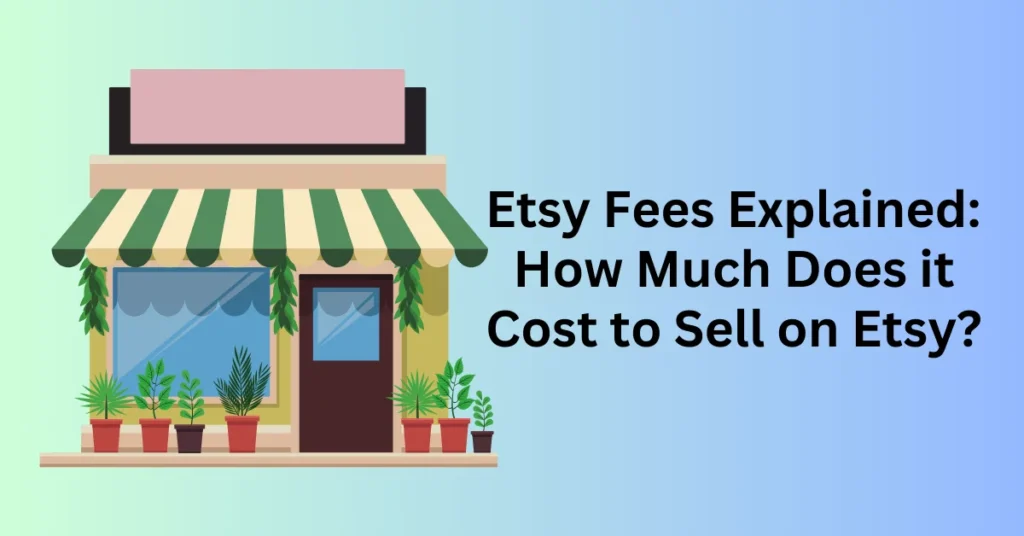Starting an Etsy shop can be an exciting venture, offering a platform to showcase your unique products and reach a global audience. However, before you dive into selling, it’s crucial to understand the associated costs. While setting up an Etsy storefront is free, various Etsy fees can impact your overall profitability.
In this blog, we’ll break down the different types of fees Etsy charges, including listing fees, transaction fees, and payment processing fees. We’ll also provide insights on how to calculate these costs and strategies to optimize your pricing for better profit margins. Whether you’re a seasoned seller or just starting out, understanding Etsy’s fee structure is essential for running a successful online shop and ensuring that your creative business thrives.
Disclaimer
The information in this article is accurate as of the current date and may change. Consult Etsy’s website for the latest information. Please consult a professional advisor for any financial or legal guidance specific to your situation.
Etsy Marketplace Fees With Etsy Payments
Creating a shop on the Etsy marketplace is a straightforward process and comes with no initial fee. However, once you begin adding product listings and making sales, you will incur three essential Etsy seller fees. It’s important to be aware of these fees to effectively manage your shop’s finances.
Etsy processes all fees through its Etsy Payments system. This system automatically records and deducts fees from your Etsy account. Understanding how to manage your account payments is crucial for successfully running your Etsy shop.
When your customers make purchases, they can use a variety of payment options through Etsy Payments, including:
- Credit Cards
- Debit/Bank Cards
- Etsy Gift Cards
- Etsy Credits
- PayPal
- Apple Pay
- Google Pay
- Country-Specific Payment Options
By familiarizing yourself with these payment methods and the fee structure, you’ll be better equipped to manage your Etsy shop efficiently and ensure a smooth selling experience.
Basic Etsy Fees
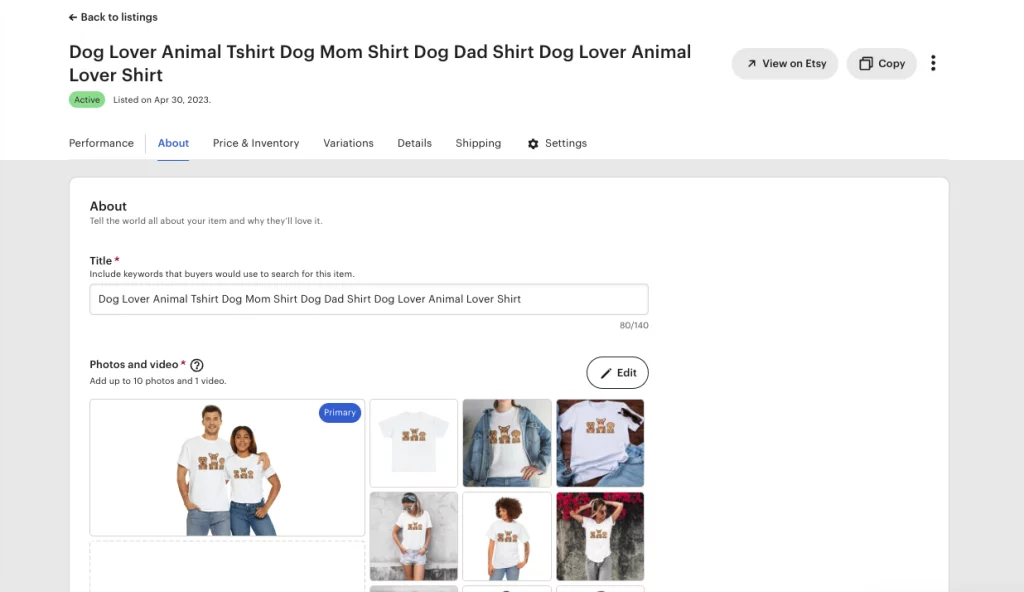
To effectively manage your Etsy shop and understand the costs involved, it’s crucial to be familiar with the various seller fees associated with selling on the platform. Here’s a breakdown of the fees you’ll encounter:
1. Listing Fees
Each time you add a new product to your Etsy store, you’ll incur a listing fee of $0.20. This fee covers the cost of keeping the product published for four months. You can edit the product listing during this period without incurring additional costs. Printify’s integration with Etsy will set your listing quantity to 999, which is the maximum number for on-demand products with no stock limits. After four months, regardless of whether you’ve sold any, some, or all of your stock, Etsy will automatically renew your listing for the same amount, charging a renewal fee of $0.20. If you prefer not to have your listings auto-renewed, you can disable this feature in your settings. The listing fee is converted from USD to your payment account’s currency using the current exchange rate, and renewed listings will retain their original view count, favourites, and URL.
2. Transaction Fees
Etsy charges a transaction fee of 6.5% on the total sale price. This includes the cost of the product, shipping, and gift wrapping. This fee is calculated based on the total transaction amount. For instance, if you sell an item priced at $10 with an additional $4 for shipping, Etsy will charge a transaction fee of $0.65 for the product price and $0.26 for the shipping, totaling $0.91.
3. Payment Processing Fees
When a sale is made, Etsy deducts a payment processing fee, which includes a fixed fee plus a percentage of the total sale price. In the US, this fee is 3% of the sale amount plus a fixed charge of $0.25. For details on payment processing fees in other countries, please consult the Etsy Help Center.
Region-Based Etsy Fees
Etsy may impose additional mandatory fees based on various factors such as your store’s listing currency, applicable taxes, and the specific operations of the Etsy platform. These fees can affect transactions on the site and may vary depending on the seller’s region.
Currency Conversion Fee (2.5%)
If your Etsy Payments account is set to a different currency than your product listings, you will incur a currency conversion fee of 2.5% on the total sale amount. This fee is automatically deducted from your Etsy Payments account. Be mindful of this fee if you operate in a currency different from your listing prices. This can impact your overall revenue.
VAT and Sales Tax
VAT
For Etsy merchants based in the European Union and certain other countries, VAT is applicable to the total buyer’s price of an Etsy listing. Additionally, Etsy is required to collect VAT on payment processing fees in eligible countries. You can refer to Etsy’s Help page to determine if additional VAT charges apply in your country. Etsy Payments users will receive an invoice detailing VAT-eligible seller fees and related charges.
Sales Tax
In the US, Etsy collects and remits sales tax for most states on a monthly basis. If you’re unsure about the applicable sales tax in your state or region, it’s best to consult with your local tax authority. Sales tax fees are summarized in your Etsy Payments account under the Sales and Fees section. You also have the option to manage and remit taxes independently if you choose to opt out of Etsy’s automatic tax collection service. The applicable sales tax fees may differ based on whether you’re selling physical items or downloadable products.
Etsy calculates and collects both VAT and sales tax on your behalf and provides a downloadable invoice at the beginning of each month, summarizing the previous month’s fees.
Taxes and Print on Demand
When integrating your Etsy account with Printify’s print-on-demand service, you can streamline the process of managing your listings. Printify’s Other Orders tab allows you to migrate existing listings to their platform without incurring additional Etsy listing fees. You can also submit VAT IDs and import unsynced orders from Etsy without extra sales tax charges. This is because these taxes will have already been applied at the marketplace level.
However, if you manually place a Printify order for a US customer, Printify will still need to apply sales tax unless you have provided a valid resale certificate. To avoid manual tax calculations, it’s best to use the Other Orders tab for automatic order imports.
Printify is working on implementing the OOS (One-Stop-Shop) and IOOS (Import One-Stop-Shop) tax collection systems to automatically apply VAT rates to end customers across Europe.
Regulatory Operating Fee
In certain countries, sellers are subject to a Regulatory Operating Fee due to new standards for digital transactions, which aim to align digital transaction costs with those of in-person sales. These fees are part of Digital Services Tax policies that address increased business costs.
To incorporate these fees into your product pricing, clearly communicate any price differences or increases through your store policies. The Regulatory Operating Fee is a percentage of the total cost of the product, including shipping, gift wrapping, and any personalization.
Regulatory Operating Fees by Country:
- United Kingdom: 0.32%
- France: 0.47%
- Italy: 0.32%
- Spain: 0.40%
- Turkey: 1.1%
Other Etsy Fees
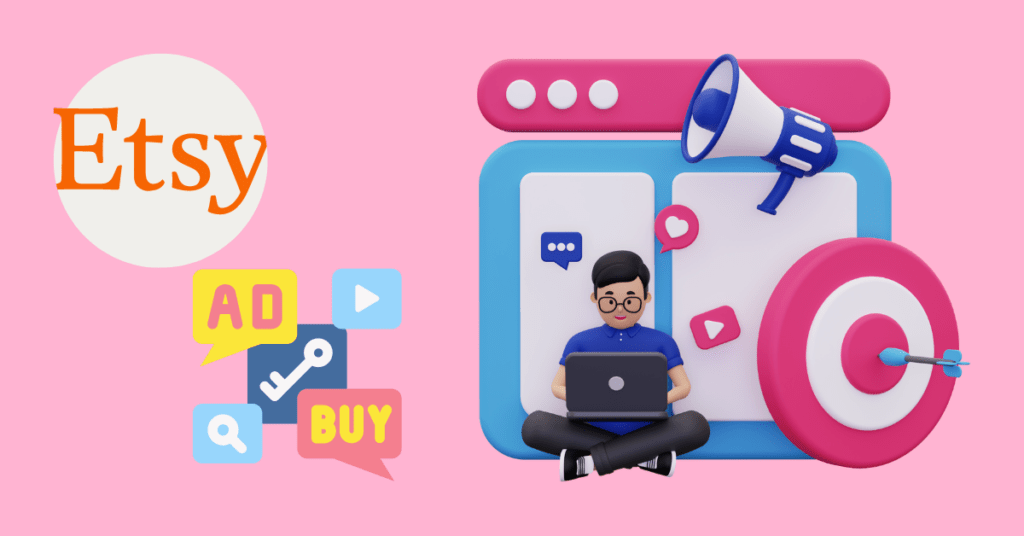
Etsy provides optional fees that can enhance your store’s visibility, product customization, and overall marketing efforts. While these fees are not mandatory, they offer valuable advantages and can be particularly useful depending on your business model and marketing strategy. Here’s a closer look at these optional fees and their impact on your overall costs:
Etsy Ads Fees (Cost per Click)
Etsy Ads are a primary tool for boosting the visibility of your listings within the Etsy marketplace. By using Etsy Ads, you can feature your chosen listings prominently in search results, category pages, and user catalogs. This increased visibility can drive more traffic to your shop and potentially lead to higher sales.
Advertising Fee Structure:
- Cost per Click (CPC): Etsy Ads operate on a cost-per-click basis. You set a daily budget ranging from $1 to $25, which determines how often your ads appear to potential buyers. A higher budget increases the frequency and visibility of your ads, potentially leading to more clicks and sales.
- Ad Visibility: Etsy evaluates your ads based on factors like optimized tags, product quality, and your cost-per-click bid compared to competitors. Listings with high demand or better optimization may receive higher visibility.
- Etsy Ads Credits: With a paid Etsy subscription, you can earn Etsy Ads credits. These credits provide a bonus for your ad listings, helping to stretch your advertising budget further.
Strategic Use:
If you have specific campaign ideas or promotions, utilizing Etsy Ads can help you achieve your marketing goals. Consider subscribing to these options if you want to leverage advertising to boost your store’s presence on Etsy.
While Etsy Ads and other optional fees offer valuable benefits, they also contribute to the overall cost of running your Etsy shop. Evaluating these costs in relation to the advantages they provide is essential for budgeting effectively and optimizing your marketing strategy.
Offsite Ads Fees (12%-15%)
Offsite advertising on Etsy is a powerful way to extend your marketing efforts beyond the Etsy platform. This feature enables you to promote your listings on external platforms such as social media apps, Etsy partner websites, and search engines, which helps broaden your reach and implement a multi-channel marketing strategy.
Besides, Offsite ads allow you to target specific audiences based on their interests and preferred social media channels. To maximize the effectiveness of your campaigns, it’s crucial to identify the best times to launch your ads and ensure they are aligned with your target audience’s behavior. Etsy monitors the performance and relevance of your listings on these external platforms, so having existing user traffic and strong Etsy SEO will enhance the chances of your ads attracting and converting potential buyers.
Fee Structure
The fees for offsite advertising are based on your store’s annual earnings and are applied as a percentage of the total sale price. For stores earning less than $10,000 annually, Etsy charges a 15% fee on the total sale price of items sold through offsite ads. However, if your store earns at least $10,000 annually, you receive a 12% discount on the offsite ad fees, reducing the fee to 13% of the total sale price for any sale attributed to the ad.
Additionally, there is a cap on the offsite advertising fee, with a maximum limit of $100 per transaction, even if the percentage fee would otherwise result in a higher amount. Sales are considered attributed to an offsite ad if a user clicks on your promoted post and completes a purchase within the following 30 days. This ensures that the fee is only applied when the ad directly contributes to a sale.
To optimize your use of offsite advertising, focus on ensuring your listings are well-optimized for Etsy SEO to attract and retain traffic. Regularly analyze the performance of your offsite ads to adjust your targeting and strategies as needed. Be sure to incorporate the potential costs of offsite advertising into your marketing budget to ensure they align with your overall business goals. By effectively leveraging offsite ads, you can enhance your store’s visibility and drive additional sales, contributing to a comprehensive marketing approach.
Subscription Fee ($10/month)
In addition to the free default Etsy Standard plan, Etsy offers an upgraded option called Etsy Plus. For a monthly subscription fee of $10, Etsy Plus provides a range of enhanced features and benefits that can significantly improve your online store and marketing efforts.
With Etsy Plus, you gain access to Etsy Ads credits, which can help you promote your listings more effectively and attract more buyers. The subscription also includes a discount on custom web addresses, allowing you to create a professional and memorable URL for your shop. Additionally, Etsy Plus offers the ability to enable restock requests from shoppers, letting you gauge interest and manage inventory more efficiently.
The plan provides advanced store customization options, enabling you to personalize your shop to a greater extent and tailor it to your brand’s needs. You’ll also receive discounts on custom promotional materials, which can be useful for creating marketing collateral to boost your store’s visibility.
While the Etsy Plus subscription fee does not directly affect how your listings rank in search results, it can have a significant impact on your shop’s growth potential. By taking advantage of the additional features and benefits, you can enhance your shop’s appearance, attract more traffic, and ultimately increase sales.
Etsy Shipping Label Fees
Etsy offers a discounted service for printing postage labels, which can significantly enhance the customer experience by allowing for more personalized and branded packaging. Custom shipping labels not only help streamline your shipping process but also add a professional touch to your orders, creating a positive first impression for your buyers.
You can purchase custom shipping labels through a variety of carriers, including:
- Australia Post
- Canada Post
- FedEx
- Global Postal Shipping
- UPS
- USPS
- Royal Mail & Evri
The cost of shipping labels will vary depending on factors such as the origin and destination of the package, as well as its dimensions. By using Etsy’s discounted label printing service, you can save on shipping costs while maintaining a high level of customization for your packaging, which can enhance your store’s branding and overall appeal to customers.
Etsy In-Person Selling Fees ($0.20)
While generating profit through online sales on Etsy is a valuable strategy, selling in person at trade shows, seasonal markets and other physical locations can also be highly beneficial. This approach allows you to reach customers face-to-face, potentially increasing your sales and expanding your brand’s visibility.
To sell in person while managing your Etsy listings, you’ll need to connect your Etsy account to the marketplace’s point-of-sale (POS) system. Etsy partners with Square Reader to facilitate in-person transactions, allowing you to display your listings and process card payments seamlessly, just as you would with an online Etsy order.
When you use Square for in-person sales, you can sync your listings with Square for the standard $0.20 listing fee, the same as for online listings. This integration helps you avoid an additional $0.20 transaction fee that applies if you do not use Square.
By leveraging Square, you can also bypass Etsy’s 6.5% transaction fee and the payment processing fee associated with online sales. Instead, Square charges its own transaction fees, which are generally lower. These fees range from 2.6% to 3.5% of the total sale cost, depending on the specific services and payment methods used.
Overall, integrating Square for in-person sales can streamline your transaction process, reduce fees, and help you manage both online and offline sales more effectively.
Etsy Pattern Fees ($15/month)
Etsy’s Pattern feature allows you to create a custom store website, offering a personalized online presence for your business. You can explore Pattern with a 30-day free trial to determine if it meets your needs. After the trial period, a subscription fee of $15 per month applies to continue using the service.
In addition to the monthly subscription fee, there are small additional costs associated with using Pattern. These include fees for domain registration and protection, as well as Etsy payment fees. Despite these additional costs, one of the significant benefits of Pattern is that it eliminates the selling and listing fees typically associated with items on Etsy.
By using Pattern, you can manage your store’s branding and online presence more effectively while avoiding these traditional Etsy fees, which can contribute to a more streamlined and cost-effective selling experience.
How Much Etsy Fees To Sell
Etsy typically takes between 20% and 25% of the total purchase price, including various fees associated with selling on the platform. To illustrate how these fees impact your potential profit when selling print-on-demand (POD) products on Etsy, we’ve created a cost-to-sell percentage estimate.
Example Calculation:
Let’s assume a US merchant is selling Printify’s bestselling Unisex Jersey Short Sleeve Tee to a customer in California. The item is priced at $21.70, including shipping, and is subject to California’s 7.25% sales tax.
Cost Description and Calculation (USD):
1. Listed Buyer’s Price (including shipping): $21.70
2. Etsy Listing Fee: -$0.20
3. Etsy Transaction Fee (including shipping): -$1.41
4. Etsy Payment Processing Fee: -$0.90
5. Sales Tax Paid by Buyer: -$1.57
Total Etsy Fees Charged: -$4.08 (19.1% of the listed buyer’s price)
Profit Breakdown:
1. Profit from Etsy Withdrawal: +$17.62
2. Printify Production Fee: -$9.82
3. Printify Shipping Fee: -$4.00
Total Printify Order Costs: -$13.82
Final Profit: +$3.80
For European sellers, additional VAT fees are typically applied, which can increase the total Etsy fees to around 30%. To manage and limit shipping costs effectively, it is advisable to select a local Print Provider for your POD products. This approach can help optimize shipping expenses and maintain more favourable profit margins.
Pros of Selling on Etsy Marketplace
An Etsy listing costs $0.20 – that’s how much you need to start. Etsy is an entry point for eCommerce selling, and you can closely follow your expenses to understand if it’s working for you or not.
If you’re a beginner eCommerce seller or have a niche customer base, watch our video on how to open a print-on-demand shop on Etsy. Without an existing audience, Etsy can help you find who your products speak to most. This is crucial for establishing a successful marketing strategy to increase brand awareness and traffic growth.
Cons of Selling on Etsy Marketplace
The initial operating costs on Etsy are relatively low, making it an appealing option for sellers who are just starting out or have a small number of sales. However, as your business scales and your sales volume increases, the cumulative effect of Etsy’s fees—such as higher listing and transaction fees—can lead to higher overall expenses. This might make selling on Etsy more costly compared to other eCommerce platforms where bulk sales and different fee structures are in place.
To illustrate the cost differences, here’s a comparison between selling on Etsy and managing your own store with Shopify using the Shopify Basic Subscription plan:
Etsy Costs:
- Listing Fee: $0.20 per item, applicable each time you add a new product listing.
- Transaction Fee: A percentage of the total sale, including the item price and shipping cost.
- Payment Processing Fee: A percentage of the total sale price, plus a fixed fee.
- Additional Fees: Variable costs may apply for features such as Etsy Ads, custom shipping labels, and offsite ads.
Shopify Costs:
- Subscription Fee: The Shopify Basic plan costs $29 per month if paid annually or $39 per month if paid monthly.
- Transaction Fees: Shopify charges fees for transactions made through its payment gateway. However, this can be lower than Etsy’s transaction fees, depending on the plan and payment processor used.
- Additional Costs: Costs may include purchasing a domain name, app integrations, and themes.
On Etsy, you will incur listing fees for each new product and subsequent sales fees. This can add up as your sales volume increases. With Shopify, you pay a fixed monthly subscription fee plus transaction fees. This may offer more predictable costs as you scale up your business.
By analyzing these costs, you can better determine which platform aligns with your business model and growth plans. Etsy’s lower initial costs are beneficial for starting out. However, as your sales grow, evaluating a more scalable solution like Shopify might be advantageous for managing costs and maximizing profitability.
Ways to Save on Etsy Fees
Offer Free Shipping
Shipping fees can vary significantly based on delivery location, which can impact your overall business expenses. To manage these costs and enhance buyer appeal, consider offering free shipping. While offering free shipping may not be sustainable for items priced under $100, it can be a powerful strategy for mid-tier and high-end products. Free shipping can positively influence buyer behaviour and reduce cart abandonment, which often occurs due to hidden shipping costs or limited shipping options.
Set Your Prices in Your Bank Account’s Currency
To avoid Etsy’s 2.5% currency conversion fee, align your Etsy shop’s currency with the currency of your payment account. This way, you eliminate the need for Etsy to convert the currency of each sale, saving on conversion fees and simplifying your accounting processes.
Evaluate What Listings to Run Ads For
Ads are a crucial aspect of your marketing strategy, so it’s important to choose your primary ad listings wisely. Focus on your best-selling items or those with the highest demand from customers. Etsy’s ad algorithm prioritizes listings with optimized tags, well-curated descriptions, and a high click-through rate. When advertising off-site, ensure your ads align with the platform’s terms of service and target demographics to effectively reach your desired audience.
Increase Prices
One effective way to manage Etsy fees and improve your profit margins is by increasing your prices. If you have items that consistently sell well, consider raising prices to better reflect their value. However, be mindful that higher prices may deter some existing customers. To counteract this, you might need to increase your advertising budget to attract new buyers. It’s important to balance price increases with market competitiveness; avoid setting prices too high above the market average to maintain your store’s appeal and assess how price changes affect your long-term sales and customer retention.
Make a Profit on Etsy With Printify
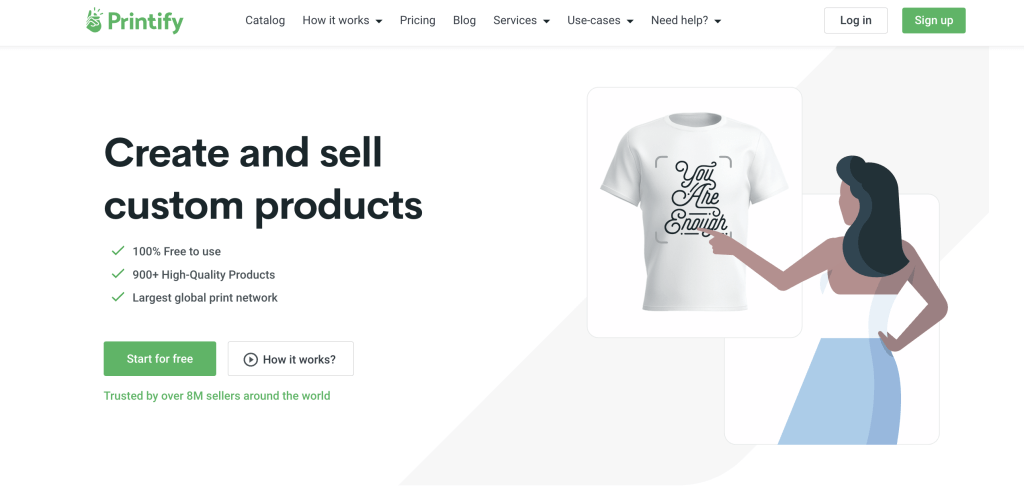
1. Sign Up
Firstly, begin your journey by registering a free Printify account. You will gain access to a range of beginner-friendly print-on-demand features designed to simplify your selling process.
2. Choose a Product
Secondly, browse through over 900 high-quality items available in the Printify Catalog. Whether you’re interested in apparel, accessories, home decor, or everyday items, you’ll find a diverse selection to choose from.
3. Design Your Product
Then, you can use Printify’s intuitive Product Creator to bring your designs to life. Customize your products with precise measurements and take advantage of free design assets to ensure your creations are exactly as you envision them.
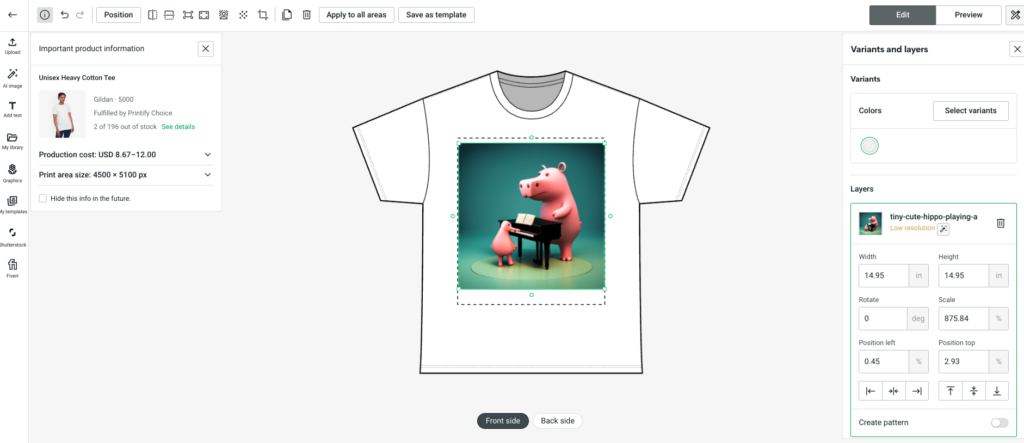
4. Sell It on Etsy
Finally, connect your Printify account to Etsy seamlessly. Then, list your custom products for free and set flexible prices to manage Etsy fees effectively.
Final Thoughts: Etsy Fees – How Much Does it Cost to Sell on Etsy?
Creating an Etsy storefront is free, but running an active business involves several fees. To accurately gauge the costs of operating an Etsy shop, you should consider the following:
Firstly, there are listing fees. Each item you list on Etsy incurs a $0.20 fee, which keeps the listing active for four months. If you need to renew or relist an item, the fee will apply again.
Secondly, you need to account for sales fees. Etsy charges a transaction fee of 6.5% on the sale price, including shipping. Additionally, a payment processing fee applies, which varies based on location and payment method. For U.S. sellers, this fee is 3% plus $0.25 per transaction.
Beyond these basic fees, there may be additional costs depending on your location and transaction details. For example, if your shop’s currency differs from your payment account’s currency, Etsy charges a 2.5% currency conversion fee. In addition, VAT applies to sales in the EU and other regions, while sales tax is collected in the U.S. based on the buyer’s location. Some countries also have regulatory operating fees due to digital transaction regulations.
To ensure profitability, calculate these mandatory fees based on your product price and set your prices to cover an average of 20%-25% in fees. This strategy helps you maintain a healthy profit margin while accommodating Etsy’s costs.
